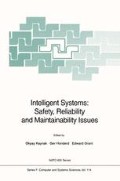Abstract
The aim of this paper is to present control issues of the Delft Intelligent Assembly Cell (DIAC) with emphasis on the planning geometrical trajectories with the aid of hermite splines. DIAC has two simultaneous operating robots each with its own working area as well as a shared working area with overlapping workspaces. The control issues of DIAC are presented and a description, goals and means of DIAC in general will be briefly discussed. Motion control of DIAC is divided in two parts: Coarse control and Fine motion control. The coarse control part is concerned with collision free simultaneous movements of the two robots over larger distances while the fine motion part is concerned with movements under contact restraints which appear during assembly operations of fitting parts together.
Access this chapter
Tax calculation will be finalised at checkout
Purchases are for personal use only
Preview
Unable to display preview. Download preview PDF.
References
P.P. Jonker, The architecture of the delft intelligent assembly cell. Milestone 1 report SPIN/FLAIR-2. Delft University of Technology, December 1988.
B.J.H. Verwer, A multi-resolution work space, multi-resolution configuration space approach to solve the path planning problem, 1990 IEEE Int. Conf. on Robotics and Automation,May 13-18, 1990, Cincinatti, USA, pp.2107–2112.
Jongkind, W., G. Honderd, B. Verwer and T. Rieswijk, The Delft intelligent assembly cell and its collision avoidance, In: Proceedings ICARCV’90 International Conference on Automation, Robotics and Computer Vision, 19-21 September 1990, Singapore, pp. 170–174.
Honderd, G., T. Rieswijk, W. Jongkind and B. Verwer. Collision avoidance of the Delft Intelligent Assembly Cell. SYROCO 1991, Vienna.
Meijer, B.R., and P.P. Jonker, The architecture and philosophy of the DIAC (Delft Intelligent Assembly Cell), Proceedings of the 1991 IEEE International Conference on Robotics and Automation, Sacramento, California, April 9-11 1991, Vol.3, pp. 2218–2233.
Greville, T.N.E. (1969) Theory and applications of spline functions, Academic Press, New York.
Kochanek, D.H.U. and Bartels, R.H. (1984): ‘Interpolating splines with local tension, continuity and bias control’, Computer Graphics, Vol. 18, No. 3, pp. 33–41.
Shin, K.G. and McKay, N.D. (1984) ‘Open-loop minimum-time control of mechanical manipulators and its application’, Proceedings 1984 American Control Conference, San Diego, CA, pp. 1231–1236.
Shin, K.G. and McKay, N.D. (1985) ‘Minimum-Time Control of Robotic Manipulators with Geometric Path Constraints’, IEEE Transactions on Automatic Control, AC-30, No. 6, pp. 531–541.
Shin, K.G. and McKay, N.D. (1986a) ‘A dynamic prograrnrning approach to trajectory planning of robotic manipulators’, IEEE Transactions on Automatic Control, AC-31, No. 6, pp. 491–500.
Shin, K.G. and McKay, N.D. (1986b) ‘Selection of near-minimum time geometric paths for robotic manipulators’, IEEE Transactions on Automatic Control, AC-31, No. 6, pp. 501–510.
Author information
Authors and Affiliations
Editor information
Editors and Affiliations
Rights and permissions
Copyright information
© 1993 Springer-Verlag Berlin Heidelberg
About this paper
Cite this paper
Honderd, G., Rieswijk, T.A., Jongkind, W. (1993). Control Issues of the Delft Intelligent Assembly Cell with Emphasis on Geometrical Trajectory Planning. In: Kaynak, O., Honderd, G., Grant, E. (eds) Intelligent Systems: Safety, Reliability and Maintainability Issues. NATO ASI Series, vol 114. Springer, Berlin, Heidelberg. https://doi.org/10.1007/978-3-642-58021-5_18
Download citation
DOI: https://doi.org/10.1007/978-3-642-58021-5_18
Publisher Name: Springer, Berlin, Heidelberg
Print ISBN: 978-3-642-63438-3
Online ISBN: 978-3-642-58021-5
eBook Packages: Springer Book Archive

